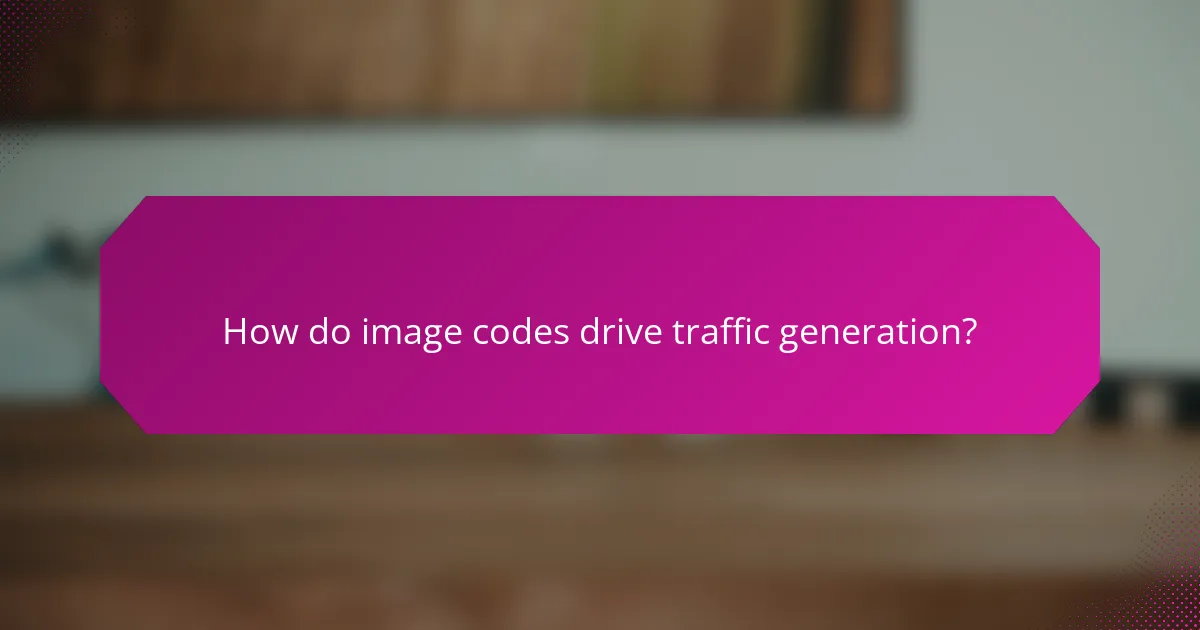Image codes serve as powerful tools for driving traffic generation, user engagement, and retention. By offering visually appealing and interactive content, they not only attract users but also encourage deeper interaction and longer visits. This enhanced engagement fosters a loyal user base, ultimately leading to increased retention and repeat visits.

How do image codes drive traffic generation?
Image codes effectively drive traffic generation by providing visually engaging content that encourages user interaction. These codes can be scanned or clicked, leading users to websites, promotions, or additional content, thereby increasing overall site visits.
Increased click-through rates
Image codes can significantly boost click-through rates (CTR) by offering a visually appealing way for users to engage with content. When users see an attractive image code, they are more likely to interact with it compared to standard text links. This can lead to CTR increases of 20-30% in some cases.
To maximize CTR, ensure that your image codes are prominently displayed and relevant to the surrounding content. Use contrasting colors and clear calls to action to draw attention.
Enhanced SEO performance
Utilizing image codes can enhance your website’s SEO performance by increasing user engagement metrics, such as time spent on site and pages per session. Search engines favor websites that keep users engaged, which can improve rankings over time.
Incorporate image codes strategically within your content, ensuring they are optimized with relevant alt text and descriptions. This not only aids in SEO but also improves accessibility for users with visual impairments.
Social media sharing benefits
Image codes are highly shareable on social media platforms, which can lead to increased traffic generation through organic sharing. Users are more inclined to share visually appealing content, making image codes an effective tool for virality.
Encourage sharing by integrating social media buttons alongside your image codes. Consider creating unique codes for specific campaigns to track engagement and effectiveness across different platforms.

What impact do image codes have on user engagement?
Image codes significantly enhance user engagement by providing interactive and visually appealing content that encourages participation. These codes can lead to increased time spent on a site and higher rates of return visits, ultimately fostering a more engaged user base.
Improved visual storytelling
Image codes facilitate improved visual storytelling by allowing brands to convey messages through engaging graphics and interactive elements. This method captures attention more effectively than text alone, making it easier for users to connect with the content.
For example, a fashion retailer might use image codes to showcase a new collection, allowing users to scan codes that reveal styling tips or videos. This immersive experience can lead to a deeper emotional connection with the brand.
Higher interaction rates
By incorporating image codes, businesses can achieve higher interaction rates as users are more likely to engage with visual content. Studies have shown that interactive elements can increase click-through rates by significant margins compared to static images.
For instance, a restaurant could use image codes on menus that link to dish preparation videos or customer reviews, prompting diners to explore more about their meal choices. This not only boosts interaction but also enhances the overall dining experience.
Personalized user experiences
Image codes can be tailored to create personalized user experiences, making interactions feel more relevant and engaging. By analyzing user behavior, businesses can customize the content linked to image codes, ensuring that it resonates with individual preferences.
For example, an e-commerce site might use image codes that lead to personalized product recommendations based on previous purchases. This targeted approach can significantly increase user satisfaction and retention, as customers feel valued and understood.

How can image codes improve user retention?
Image codes can significantly enhance user retention by creating a more engaging and interactive experience. By incorporating visual elements that resonate with users, businesses can foster a stronger connection and encourage repeat visits.
Consistent branding elements
Using image codes that reflect consistent branding elements helps establish a recognizable identity. This consistency can include logos, color schemes, and design styles that align with the overall brand message. When users encounter familiar visuals, they are more likely to feel a sense of trust and loyalty.
For example, a retail brand might use image codes that incorporate their signature colors and logo, making it easy for customers to identify promotions or products. This familiarity can lead to increased brand recall and repeat interactions.
Engaging multimedia content
Image codes can serve as gateways to engaging multimedia content, such as videos or interactive graphics. By scanning a code, users can access rich content that enhances their experience and keeps them interested. This engagement can lead to longer session times and a higher likelihood of return visits.
Consider a restaurant using image codes on their menus that link to cooking videos or customer testimonials. This not only provides valuable information but also entertains users, making them more likely to return for future dining experiences.
Enhanced user satisfaction
Image codes can enhance user satisfaction by providing quick access to relevant information and offers. When users can easily find what they are looking for, their overall experience improves, leading to higher retention rates. A seamless experience encourages users to return rather than seek alternatives.
For instance, a travel agency might use image codes that lead to personalized travel deals based on user preferences. By catering to individual needs, businesses can significantly boost user satisfaction and loyalty, resulting in repeat customers.

What are the best practices for implementing image codes?
To effectively implement image codes, focus on selecting the right formats, optimizing alt text, and ensuring responsive design. These practices enhance traffic generation, user engagement, and retention by improving accessibility and user experience.
Optimal image formats and sizes
Choosing the right image formats and sizes is crucial for performance and user experience. Common formats include JPEG for photographs, PNG for images requiring transparency, and SVG for vector graphics. Aim for file sizes under 100 KB for faster loading times, especially on mobile devices.
Consider using tools like ImageOptim or TinyPNG to compress images without significant loss of quality. Additionally, implement lazy loading to defer loading off-screen images, which can improve initial page load speed.
Effective alt text usage
Alt text is essential for accessibility and SEO. It provides descriptions of images for screen readers and helps search engines understand the content. Use concise, descriptive phrases that accurately convey the image’s purpose, ideally under 125 characters.
Avoid keyword stuffing; instead, focus on clarity and relevance. For example, instead of “dog running fast,” use “Golden Retriever running on the beach.” This approach enhances user engagement and improves search visibility.
Responsive design considerations
Responsive design ensures images adapt to various screen sizes, enhancing user experience across devices. Use CSS techniques like media queries to serve different image sizes based on the user’s device, ensuring optimal loading times and display quality.
Employ the srcset attribute in HTML to specify multiple image sources for different resolutions. This practice allows browsers to select the most appropriate image, reducing bandwidth usage and improving load times on mobile networks.

What tools can enhance image code effectiveness?
Several tools can significantly improve the effectiveness of image codes by optimizing tracking, design, and overall user engagement. Utilizing platforms like Google Analytics and Canva can help streamline these processes and enhance the impact of your image codes.
Google Analytics for tracking
Google Analytics is essential for tracking the performance of image codes. It allows you to monitor user interactions, such as clicks and conversions, providing insights into how well your images are driving traffic and engagement.
To effectively use Google Analytics, set up event tracking for your image codes. This involves defining specific actions you want to measure, such as clicks on an image, and implementing the necessary code snippets. Regularly review the data to identify trends and optimize your strategies accordingly.
Canva for design
Canva is a user-friendly design tool that can enhance the visual appeal of your image codes. With a variety of templates and design elements, you can create eye-catching images that attract user attention and encourage engagement.
When using Canva, focus on maintaining brand consistency and optimizing images for different platforms. Consider factors such as resolution and file size to ensure quick loading times, which can positively impact user retention. Experiment with different designs and monitor their performance to find what resonates best with your audience.
